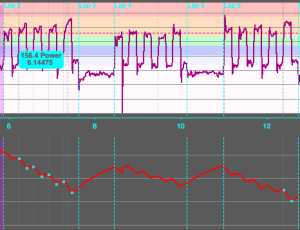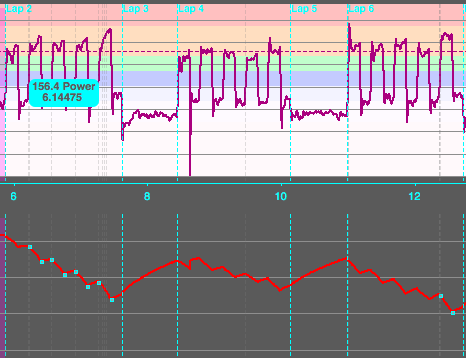VO2 max training is one of my secret keys to building strong cyclists, and it's the key to unlocking bigger functional threshold power (FTP) gains later in your training. Physiologically, VO2 max is the maximal amount of oxygen your body can use during high-intensity exercise. FTP is simply a fraction of that maximal amount under which your body is primarily producing energy through aerobic means. Basically, think of VO2 max as your fitness “ceiling”. You can only increase your FTP so far before you start running into that ceiling, so you have to “raise the roof” on your fitness if you want to bump your FTP up further.
Here's the part most people don't realize: you don't need to backload your program with a ton of 5 to 8-minute intervals in order to accomplish the goal of VO2 max training.
VO2 Max Training In 30 Seconds?
Microburst training is one of the many tools I use to build fitness in the athletes I coach. Surprisingly, microburst training (which is a fancy way of saying really short, really hard repetitive interval training) is a quick way to boost your cycling fitness and make you stronger and faster. It's been tested time and time again, and while it's TRUE that you can build big fitness in 30 second blocks, you have to be prepared to bury yourself in the pain cave for a while. If you're able to handle the intensity, you'll end up realizing fitness gains you never believed you'd find in such a short time.
 Microburst Your Vo2 Max Training
Microburst Your Vo2 Max Training
It has long been thought that in order to train VO2 max, you have to go hard for 3-8 minutes. That specific work duration is thought to create the necessary physiological stress that stimulates VO2 max level adaptations. Some recent research has shown that the biggest VO2 max adaptations occur when highly stressing anaerobic work capacity, but not necessarily all in one shot. Let's talk physiology for a moment: Over the counter viagra
If your body is called upon to work above your FTP, it's going to preferentially use anaerobic systems and fuels first. These are fast burning but highly inefficient, meaning you can't sustain those levels of exertion for very long. So, when you're working above FTP, you're burning up your anaerobic work capacity (or W' as I described here.) Once that W' or anaerobic capacity is burned up, your body has no choice but to turn up the VO2 max machinery to accommodate for the increased workload. The key to getting adaptation out of a VO2 max session is to spend plenty of training time at low anaerobic work capacity or W'. By doing this, you're depleting the body of anaerobic fuel and energy, exhausting the anaerobic system and stimulating your body to increase oxygen carrying capacity, increase the efficiency of energy substrate use and improve acid buffering systems.
The net effect is an increase in VO2 max, or your fitness “ceiling.” And as a consequence, if you raise the ceiling, you raise your FTP as well (the two tend to be linked.) Nexium otc
How do 30 second intervals do this, you ask?
Look back at the graph above for a second: the W' or anaerobic work capacity (AWC) declines during 30 second on/30 second off intervals and rises again between sets. Interestingly, even though there is equal rest and work periods, the overall W' trend is downward. This happens because the intervals are extremely short in duration but mich higher intensity than your standard VO2 max interval intensity. In fact, these types of 30/30 intervals trend towards Zone 6 or Zone 7 intensity level. That means a significant portion of W' is expended with each “on” interval, and the rest period is not long enough to recharge it to pre-interval levels, so there is a net decrease in W'.
Following the W' trend line on the example above reveals why these 30/30s are so good at stimulating VO2 max development: they are highly repeatable so you can keep your W'/AWC below the theorized “magic number” of 25% of total W'/AWC for longer periods of time than if you were doing 3-8 minute intervals. (Current research seems to indicate that most VO2 max physiological adaptations happen when W' or AWC is depleted to 25% or less of it's resting level. This is typically the level where you would score 9-9.5/10 on an RPE scale and is generally considered to be extremely hard to train at for any extended length of time, leading to fading of the effort and poor quality intensity at the end of the effort.) Lisinopril over the counter
With those factors taken into consideration, if you were to graph a set of five 5-minute intervals with the typical 1:1 or 1:.75 work/rest ratio, you may find that you only hit sub-25% levels for only about a minute of each interval (5 minutes of total adaptive effort), and the required rest intervals allow for significant recharging of W'/AWC. The key to these microburst VO2 max training sessions is to deplete your body's ability to exercise above threshold using anaerobic systems and drive VO2 max adaptation. In the case of these 30/30s, you may be able to spend twice as long below 25% because of the super high intensity short duration intervals with associated short rest periods, allowing you to repeat them for longer periods of time before hitting exhaustion. Additionally, the amount of W' depletion can be altered by adjusting the rest interval intensity as well. In theory, the greatest recharge in W' would occur during complete rest, so any activity will decrease the recharge ability of your W' system. Thusly, if you wanted to really get a very hard workout and drive W' through the basement floor, you would simply need to raise the intensity of your “rest” intervals to closer to 100% FTP.
You should really note that longer duration intervals shouldn't be ignored, simply because they train your body for longer durations of high-intensity work. They are not nearly as repeatable as 30/30s, but they can be used alongside 30/30s for additional boosts in fitness. When used in a well-designed training program, you can actually spend MORE time stimulating VO2 max with 30/30s than you may be able to do with longer duration intervals, making them a valuable tool in your training toolbox.
VO2 Max Workouts
If you really want to kick your VO2 max training into high gear, you can add the following workouts once per week during the base phase and up to twice per week during the build and peak phase. Be 100% sure you are well rested before these workouts though, as they are REALLY tough!
Short and Long: 30/30s prep you for a sufferfest above threshold. You'll start with a 5 minute block of 30 seconds as hard as you can go followed by 30 seconds of rest. Rest is anything from easy pedaling (the first time you do these workouts you'll want to just spin easy) to tempo pace (as you get more comfortable with the intervals and want to tax your body a little more.) Following the last 30 second rest, launch directly into a 5 minute VO2 interval with an intensity around 110% of your FTP and hold it the best you can. Take 7-10 minutes rest then repeat it again.
Worst 5 minutes known to mankind (and pyramid variation): Be prepared for varying lengths of intervals today (which is a great way to build race pace fitness.) Start with 10 seconds all out with 50 seconds of recovery. Next move to 20 seconds all out with 40 seconds recovery. Then 30 on/30 off. Then 40 on/20 off. Finally, 50 seconds all out with 10 seconds of recovery. Do 2 sets with 3 minutes of rest between them. If you're feeling up to a huge challenge, you can do the “pyramid” by completing the 5 minutes then immediately reversing the order and going back down. So 10/50, 20/40, 30/30, 40/20, 50/10, 50/10, 40/20, 30/30, 20/40, 10/50. Beware: that pyramid is REALLY HARD!
30/30s For The Win: It's all about short duration power today. Start with a block of 5 minutes of 30 seconds all out/30 seconds rest. Take 2 minutes rest then launch into a race winner. What's a “race winner”? It simulates attacking a field and breaking away. Start off by sprinting all out for 10 seconds, then ride 20 seconds at 150% FTP, followed by 3 minutes at 115% FTP. Sprint as hard as you still can for the last 10 seconds of the interval. You're looking at 3:30 of pure VO2 max beatdown. Rest for 5-7 minutes and then do it all over again.
Use those workouts to bolster your VO2 max training and before you know it you'll find yourself at the front of every pack. If you're looking for more structured implementation of these kinds of workouts, check out my downloadable training plans and consider some one-on-one coaching to help you implement these techniques properly. Don't forget to click the icons on the left side of the page to share with your friends.

Thanks for the article. Could you indicate references you discuss here, like the research showing 30s bouts are more effective at enhancing VO2max than longer bouts? Also, do you have scientific references about the 25% W’ target during training?
Also, when you say 30 seconds bouts should be all-out, would the power be somewhere near the CP1 (maximal power for 1 minute effort)?
Hey Jonathan,
Much of the information is related to the old Tabata Research, with studies like this: https://www.researchgate.net/profile/Motohiko_Miyachi/publication/14079610_Metabolic_profile_of_high_intensity_intermittent_exercises/links/09e4150a2d1c5e08de000000.pdf.
There’s some ex phys thought going on there that you need to be able to recover sufficiently to complete the intervals at maximal but still work intensely enough to create physiological adaptation.
The W’ discussion has a lot of roots in some of Skiba’s work (and much of it came from discussions on the Google Wattage group.) However the W’ discussion follows that your body will utilize the most readily available energy substrate, and in high intensity situations, that’s anaerobic substrate first.
Finally, for all out work, I wouldn’t generally attempt to label it. I’d suggest a user defined “all out maximal” effort to make sure you create sufficient adaptations. However, you could use CP1 as a benchmark for cutting the session: if you can’t maintain CP1, you’re likely too fatigued to complete the intervals properly.